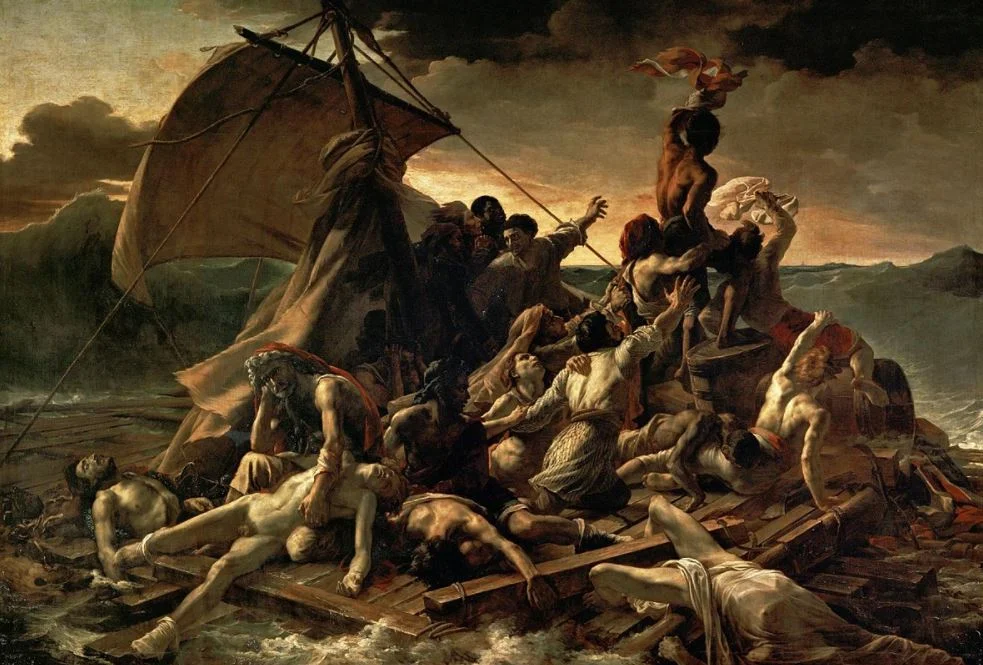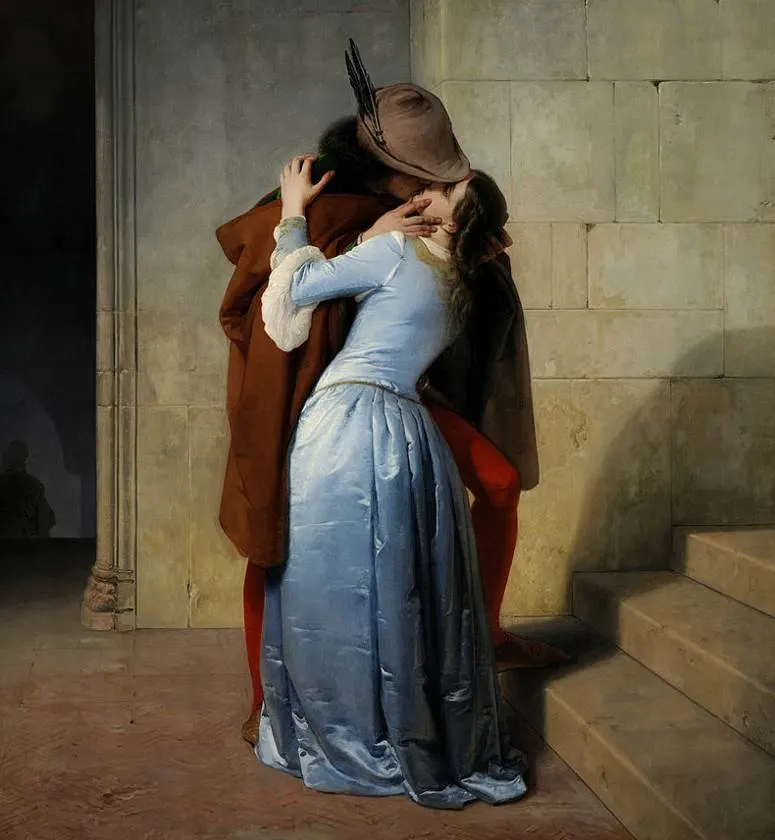The Romantic era emerged in the late 18th century and early 19th century. This was a period of turmoil in which emotional feelings and individualism became increasingly important for Romantic artists.
The movement expanded from music and literature into the visual arts and had a profound impact on life in the 19th century.
Romanticism had its roots in the “Sturm und Drang” movement in Germany which was a reaction against the rationalism of the Age of Enlightenment.
The French Revolution cemented these feelings and allowed sympathizers of the cause to express themselves in a completely new way. This lasted until the decline of Romanticism around halfway through the 19th century when Realism artists emerged.
In this article, you’ll discover some of the most famous Romantic paintings, artworks that define the Romanticism art movement.
1. The Raft of the Medusa
- Date created: 1818-1819
- Dimensions: 490 × 716 centimeters (16 feet 1 inch × 23 feet 6 inches)
- Location: Louvre Museum, Paris, France
The Raft of the Medusa was originally named “Scène de Naufrage” or “Shipwreck Scene.” It’s considered to be one of the most famous and most influential Romantic paintings ever produced and the ultimate masterpiece of French artist Théodore Géricault (1791–1824).
The painting depicts the demise of a French ship named “Méduse” that ran aground off the coast of modern-day Mauretania in 1816. This was after the Bourbon Restoration and resulted in the death of dozens of people after they were stuck on the sea for 13 days.

2. Liberty Leading the People
- Date created: 1830
- Dimensions: 260 × 325 centimeters (102.4 × 128 inches)
- Location: Louvre Museum, Paris, France
Liberty Leading the People is arguably the most famous painting in French history. Its the ultimate masterpiece of French Romantic artist Eugène Delacroix (1798-1863), the leading artist of the Romantic era following the death of his friend and colleague Théodore Géricault.
It was produced to commemorate the French Revolution of 1830, an event that once again toppled the French monarchy. The woman is the personification of Liberty and is associated with Marianne, the symbol of France and the French Republic.

3. Wanderer above the Sea of Fog
- Date created: 1818
- Dimensions: 94.8 × 74.8 centimeters (37.3 × 29.4 inches)
- Location: Hamburger Kunsthalle, Hamburg, Germany

Wanderer above the Sea Fog is also known as “Wanderer above the Mist” and is the best-known work of the leading German artist of the Romantic era Caspar David Friedrich (1774-1840). It’s one of the most defining Romantic paintings ever produced.
The man stands on top of a rock and stares into the hazy distance, something often referred to as the ultimate symbol of self-reflection. The contemplation of life and one’s emotions was one of the drivers of the Romantic movement and is perfectly depicted in this renowned work of art.

4. The Third of May 1808
- Date created: 1814
- Dimensions: 268 × 347 centimeters (106 × 137 inches)
- Location: Prado Museum, Madrid, Spain
The Third of May 1808 is arguably one of the most revered works of art by Spanish artist Francisco Goya (1746-1828), the leading figure of Romanticism in Spain in the late 18th and early 19th centuries. The painting has an accompanying work called “The Second of May 1808.”
The painting was produced to commemorate the resistance of the Spanish people against the army of Napoleon during the Peninsular War, a war fought in the Iberian Peninsula and a crucial event during the Napoleonic Wars. It’s one of the first paintings in history that depicted the true atrocities of war as opposed to a glorified version of the events.

5. The Fighting Temeraire
- Date created: 1839
- Dimensions: 90.7 × 121.6 centimeters (35.7 × 47.9 inches)
- Location: National Gallery, London, United Kingdom
The Fighting Temeraire is officially known as “The Fighting Temeraire, tugged to her last berth to be broken up, 1838,” a title that clearly explains what it depicts. It’s one of the most renowned works by the eccentric English artist named Joseph Mallord William Turner (1775-1851) or J.M.W. Turner.
The 98-gun HMS Temeraire was originally launched in 1798 and was depicted by Turner on its final journey towards Rotherhithe, a borough in the southeast of London. Here, the ship that once fought at the Battle of Trafalgar in 1805, was turned to scrap.

6. The Death of Sardanapalus
- Date created: 1827
- Dimensions: 392 × 496 centimeters (154 × 195 inches)
- Location: Louvre Museum, Paris, France
The Death of Sardanapalus is another monumental work of art produced by French artist Eugène Delacroix. It depicts the story of the demise of Sardanapalus, the last king of Assyria, who according to the story was a figure who indulged in extremely lavish forms of hedonism.
Delacroix used vivid colors to portray a scene of bitter chaos as the king calmly awaits his faith. The painting was exhibited at the Paris Salon of 1828 and although it was received with mixed reviews, the artist made a replica of the work in 1844, a smaller version that can now be admired at the Philadelphia Museum of Art.

7. Wivenhoe Park
- Date created: 1816
- Dimensions: 56.1 × 101.2 centimeters (22.1 × 39.8 inches)
- Location: National Gallery of Art, Washington, D.C., United States
Wivenhoe Park is one of the most celebrated works by Engish landscape painter of the Romantic era John Constable (1776-1837). Born and raised in Suffolk, the region known as Dedham Vale is now referred to as “Constable Country” due to the large number of paintings he produced here.
This painting depicts an idyllic landscape and an estate that was owned by the Rebow family. It features an extreme sense of harmony and almost photographic clarity. It makes Wivenhoe Park, a green area on the outskirts of Colchester, one of the most amazing sceneries imaginable.

8. Saturn Devouring His Son
- Date created: 1819-1823
- Dimensions: 143 × 81 centimeters (56 × 32 inches)
- Location: Prado Museum, Madrid, Spain
Saturn Devouring His Son is one of the 14 dark paintings that Francisco Goya painted on the walls of his house between 1819 and 1823. These paintings were transferred to canvas after the artist passed away and moved to the Prado Museum in Madrid.
This particular work depicts a Greek myth in which Saturn ate one of his newly-born sons because he feared that he would be overthrown by him. He wasn’t the first artist to paint this subject, though, but it was one of the most intriguing versions of this story.

9. The Oxbow
- Date created: 1836
- Dimensions: 130.8 × 193 Centimeters (51.5 × 76 inches)
- Location: Met Museum, New York City, United States
The Oxbow is officially known as “View from Mount Holyoke, Northampton, Massachusetts, after a Thunderstorm.” It’s one of the most famous works of art by American artist Thomas Cole (1801-1841) depicts an amazing view of the Connecticut River Valley.
The American artist was the founder of the Hudson River School, an art movement formed by landscape painters who drew inspiration from the most renowned Romantic artists. Some art historians consider this work to be a clash between the wilderness and civilization, split in half by a darker and brighter side.

10. The Kiss
- Date created: 1859
- Dimensions: 110 × 88 centimeters (43 × 35 inches)
- Location: Pinacoteca di Brera, Milan, Italy
The Kiss is the best-known work by the Italian artist of the Romantic era named Francesco Hayez (1791-1882). It was commissioned by Count Alfonso Maria Visconti of Saliceto, a town in the northern part of Italy.
The painting at the Pinacoteca di Brera isn’t the only version of the painting as the artist produced both another oil painting and a watercolor of the same subject. The only difference in the oil painting is that the girl wears a white dress instead of a blue one.

